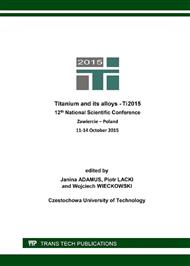p.92
p.98
p.106
p.111
p.117
p.125
p.133
p.141
p.149
The Destruction Mechanism of Titanium Subjected to Cavitation Erosion
Abstract:
A cavitation erosion is the process based on an impact of pressure pulses on a material’s surface caused by the phenomenon of cavitation. The term cavitation is defined as a phenomenon of formation, growth and disappearance (implosion) of bubbles due to cyclic pressure variations in a liquid. The cavitation initiators are embryos (cavitation nuclei with a size up to 50 μm), located in the water or on wetted surfaces that lead to decreasing of the liquid ability to transfer tensile stresses. The role of embryos is played by micro gas bubbles, fine solid particles, micro-organisms or gas-filled pores on a surface of solid body embedded in a liquid. A rapid pressure drop occurring within the liquid and a presence of cavitational kernel causes rupture the continuity of the liquid and thus lead to the formation of steam-gas mixture areas, a so called cavitation bubbles. A cavitation bubble may be filled with a gas, a vapor or a steam/gas mixture.A course of cavitation depends on a cavitation type. In thepresent work, a mechanism of cavitiational destruction of 99,7 % titaniumtested on vibrational and jet-impact valaboratory stands, is analyzed. Results of thecavitational resistance evaluation of Ti99.7 titanium carried out onvibrational and jet-impact stands have revealed different mechanisms of acavitation destruction caused by various forms of cavitation. It was found thata surface of titanium samples tested on the vibratory stand was covered by verylarge number of microcracks which in a later stage of the research leads to theerosion of the material. The cavitational destruction of Ti samples on the jet-impact stand is initiatedby a plastic straining of subsurface area, which in the further stage leads toan erosion represented by the detachment of whole grains anda formation of deep pits on the material’s surface. Additionally, results of conducted studies have confirmed the fatigue character of the cavitationaldestruction process.
Info:
Periodical:
Pages:
117-122
Citation:
Online since:
April 2016
Authors:
Keywords:
Price:
Сopyright:
© 2016 Trans Tech Publications Ltd. All Rights Reserved
Share:
Citation:


